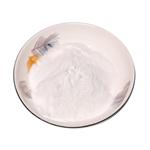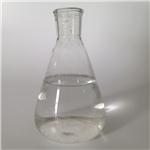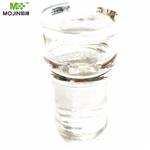Amyl acetate
- CAS No.
- 628-63-7
- Chemical Name:
- Amyl acetate
- Synonyms
- PENTYL ACETATE;N-AMYL ACETATE;ACETIC ACID PENTYL ESTER;N-PENTYL ACETATE;n-amyl;1-PENTYL ACETATE;normal;PEAR OIL;ai3-02729;Birnenoel
- CBNumber:
- CB7166381
- Molecular Formula:
- C7H14O2
- Molecular Weight:
- 130.18
- MDL Number:
- MFCD00009500
- MOL File:
- 628-63-7.mol
- MSDS File:
- SDS
| Melting point | −100 °C(lit.) |
|---|---|
| Boiling point | 142-149 °C(lit.) |
| Density | 0.876 g/mL at 25 °C(lit.) |
| vapor density | 4.5 (vs air) |
| vapor pressure | 4 mm Hg ( 20 °C) |
| refractive index |
n |
| Flash point | 75 °F |
| storage temp. | Store below +30°C. |
| solubility | 10g/l |
| form | Powder |
| color | White |
| Odor | Pleasant banana-like; mild; characteristic banana- or pear-like odor. |
| explosive limit | 1.1-7.5%(V) |
| Odor Type | fruity |
| Water Solubility | 10 g/L (20 ºC) |
| FreezingPoint | -70.8℃ |
| BRN | 1744753 |
| Henry's Law Constant | 10.73 at 37 °C (static headspace-GC, Bylaite et al., 2004) |
| Exposure limits | TLV-TWA 100 ppm (~525 mg/m3) (ACGIH, MSHA, and OSHA); IDLH 4000 ppm. |
| Dielectric constant | 5.0(20℃) |
| LogP | 2.300 |
| Indirect Additives used in Food Contact Substances | AMYL ACETATE |
| FDA 21 CFR | 175.105 |
| CAS DataBase Reference | 628-63-7(CAS DataBase Reference) |
| EWG's Food Scores | 1 |
| FDA UNII | 92Q24NH7AS |
| NIST Chemistry Reference | Acetic acid, pentyl ester(628-63-7) |
| EPA Substance Registry System | n-Amyl acetate (628-63-7) |
SAFETY
Risk and Safety Statements
| Symbol(GHS) |  GHS02 |
|||||||||
|---|---|---|---|---|---|---|---|---|---|---|
| Signal word | Warning | |||||||||
| Hazard statements | H226 | |||||||||
| Precautionary statements | P210-P233-P240-P241-P242-P243 | |||||||||
| Hazard Codes | Xi | |||||||||
| Risk Statements | 10-66 | |||||||||
| Safety Statements | 23-25-24/25 | |||||||||
| RIDADR | UN 1104 3/PG 3 | |||||||||
| WGK Germany | 3 | |||||||||
| RTECS | AJ1925000 | |||||||||
| F | 21 | |||||||||
| Autoignition Temperature | 680 °F &_& 714 °F | |||||||||
| TSCA | Yes | |||||||||
| HazardClass | 3 | |||||||||
| PackingGroup | III | |||||||||
| HS Code | 29153930 | |||||||||
| Toxicity | Acute oral LD50 for rats 6,500 mg/kg (quoted, RTECS, 1985). | |||||||||
| IDLA | 1,000 ppm | |||||||||
| NFPA 704 |
|
Amyl acetate price More Price(23)
| Manufacturer | Product number | Product description | CAS number | Packaging | Price | Updated | Buy |
|---|---|---|---|---|---|---|---|
| Sigma-Aldrich | 8.18700 | n-Amyl acetate EMPLURA? | 628-63-7 | 1L | $105 | 2024-03-01 | Buy |
| Sigma-Aldrich | 46022 | Pentyl acetate puriss. p.a., ≥98.5% (GC) | 628-63-7 | 250ML | $86.9 | 2024-03-01 | Buy |
| Sigma-Aldrich | 46022 | Pentyl acetate puriss. p.a., ≥98.5% (GC) | 628-63-7 | 1L | $187 | 2024-03-01 | Buy |
| Sigma-Aldrich | 109584 | Pentyl acetate 99% | 628-63-7 | 250ml | $77.1 | 2024-03-01 | Buy |
| Sigma-Aldrich | 109584 | Pentyl acetate 99% | 628-63-7 | 1l | $179 | 2024-03-01 | Buy |
Amyl acetate Chemical Properties,Uses,Production
Description
All isomers of amyl acetate are highly flammable, colorless to yellow, watery liquids. The n- and isoisomers have a persistent, fruity, banana-like or pear-likeodor. The sec-isomer has a mild fruity odor. Molecularweight of isomers 5 130.21. Hazard Identification (basedon NFPA-704 M Rating System): (sec-isomer) Health 2,Flammability 3, Reactivity 0.n-isomer: Boiling point= 121℃; Melting/Freezingpoint=2 72℃; Specific gravity= 0.876 at 20℃; Liquidsurface tension= 5 0.012 N/m at 30℃; Liquid water interfacial tension 5 (estimate) 0.05 N/m at 17℃; Relative vapordensity (air= 1) 5 4.5; Ratio of specific heats of vapor(gas) 5 1.1; Latent heat of vaporization= 3.1 3 105 J/kg;Heat of combustion 5 2 310.8 3 105 J/kg; Vaporpressure= 0.93 kPa at 20℃; Flash point= 16°21℃, 25℃(cc); Autoignition temperature= 360℃; Explosive limits:LEL 5 1.0%; UEL 5 7.5%; Odorthreshold 5 0.0075°7.3 ppm.sec-isomer: Boiling point= 121℃; Melting/Freezingpoint=2 148℃; Critical temperature= 326℃; Criticalpressure= 411.6 psia 5 28.0 atm 5 2.83 MN/m2; Specificgravity= 0.861°0.866 at 20℃; Liquid surface tension 5 28.9 dynes/cm 5 0.0289 N/m at 20℃; Liquidwater interfacial tension 5 (estimate) 0.0441 N/m at20℃; Relative vapor density (air= 1) 5 4.5; Ratio of specific heats of vapor (gas) 5 (estimate).1°1.1 at 20℃;Latent heat of vaporization= (estimate) 5 3.0 3 105 J/kg;Heat of combustion 5 2 14.402 Btu/lb 5 2 8000cal/g 5 2 334.9 3 105 J/kg; Vapor pressure= 7 mmHg at20℃; Flash point= 32℃; Explosive limits: LEL 5 1.1%;UEL 5 7.0%; Odor threshold 5 0.002 ppm.tert-isomer: Boiling point= 125℃; Flash point= 26℃;Explosive limits: LEL 5 1.0%; UEL 5 7.5%; Odor threshold 5 0.08 *0.0006 in water.iso-isomer: Boiling point= 142℃; Melting/Freezingpoint=2 78.5℃; Critical temperature 326.1℃; Criticalpressure= 2.84 MN/m2; Specific gravity= 0.876 at 15℃;Liquid surface tension= 5 0.02477 N/m at 20℃; Liquid waterinterfacial tension5 0.0502 N/m at 15℃; Relative vapor density (air= 1) 5 4.5; Ratio of specific heats of vapor (gas) 5(estimate).1°1.1; Latent heat of vaporization= (estimate) 53.07 3 105 J/kg; Heat of combustion 5 2 334.9 3 105 J/kg;Vapor pressure= 4 mmHg at 20℃; Autoignitiontemperature5 379℃; Flash point= 25℃; Autoignitiontemperature5 379℃; Explosive limits: LEL5 1.2% at 100℃;UEL 5 7.5%; Odor threshold 5 0.015.They all float on water and have poor (slight to negligible)solubility. Water contact forms a flammable, irritatingvapor. Hazard Identification (based on NFPA-704 M RatingSystem): Health 1, Flammability 3, Reactivity 0.*The range of accepted odor threshold values is quite broadand caution should be used in relying on odor alone as awarning of potentially hazardous exposure.
Chemical Properties
All isomers of amyl acetate are highly flammable, colorless to yellow, watery liquids.
Physical properties
Colorless liquid with a sweet, banana-like odor. A detection odor threshold concentration of 275 μg/m3 (52 ppbv) was reported by Punter (1983). Cometto-Mu?iz and Cain (1991) reported an average nasal pungency threshold concentration of 1,650 ppmv.
Uses
Banana essence. Used as test odorant in studies of olfactory function and in studies of the psychosocial effects of odor.
Uses
n-Amyl acetate is used as a solvent forlacquers and paints; in fabrics’ printing; innail polish; and as a flavoring agent.
Uses
A colorless liquid made by adding sulfuric acid to a mixture of amyl alcohol and acetic acid with subsequent recovery by distillation. It is slightly soluble in water but insoluble in alcohol. Amyl acetate was used as one of the solvents in making celluloid film and as fuel for the Alteneck lamp, adopted as the standard light in sensitometry by the International Congress of Photography in 1889.
Production Methods
n-Amyl acetate is the produced by the esterification of N-amyl alcohol with acetic acid.
Definition
ChEBI: An acetate ester of pentanol.
Synthesis Reference(s)
Synthetic Communications, 21, p. 1545, 1991 DOI: 10.1080/00397919108021051
Tetrahedron Letters, 50, p. 395, 2009 DOI: 10.1016/j.tetlet.2008.11.024
The Journal of Organic Chemistry, 45, p. 2915, 1980 DOI: 10.1021/jo01302a035
General Description
A mixture of isomers. A clear colorless liquid with a banana-like odor. Flash point varies from 65°F. to 95°F. Less dense (at 7.2 lb / gal) than water and slightly soluble in water. Hence floats on water. Vapors heavier than air.
Air & Water Reactions
Highly flammable. Slightly soluble in water.
Reactivity Profile
AMYL ACETATE is an ester. Esters react with acids to liberate heat along with alcohols and acids. Strong oxidizing acids may cause a vigorous reaction that is sufficiently exothermic to ignite the reaction products. Heat is also generated by the interaction of esters with caustic solutions. Flammable hydrogen is generated by mixing esters with alkali metals and hydrides. Amyl acetate is incompatible with the following: Nitrates; strong oxidizers, alkalis & acids .
Hazard
Flammable, high fire risk. Explosive limits in air 1.1–7.5%.
Health Hazard
n-Amyl acetate is a narcotic, an irritant tothe eyes and respiratory passage, and at highconcentrations, an anesthesia. Exposure toabout 300 ppm in air for 30 minutes mayproduce eye irritation in humans. Higherconcentrations (>1000 ppm) may produceheadache, somnolence, and narcotic effects.Exposure to 5200 ppm for 8 hours was lethalto rats. It is more toxic than the loweraliphatic esters. An LD50 value in rats iswithin the range 6000 mg/kg.
Fire Hazard
HIGHLY FLAMMABLE: Will be easily ignited by heat, sparks or flames. Vapors may form explosive mixtures with air. Vapors may travel to source of ignition and flash back. Most vapors are heavier than air. They will spread along ground and collect in low or confined areas (sewers, basements, tanks). Vapor explosion hazard indoors, outdoors or in sewers. Runoff to sewer may create fire or explosion hazard. Containers may explode when heated. Many liquids are lighter than water.
Chemical Reactivity
Reactivity with Water No reaction; Reactivity with Common Materials: No reaction; Stability During Transport: Stable; Neutralizing Agents for Acids and Caustics: Not pertinent; Polymerization: Not pertinent; Inhibitor of Polymerization: Not pertinent.
Safety Profile
Moderately toxic by intraperitoneal route. Human systemic effects by inhalation: conjunctiva irritation, headache, and somnolence. A human eye irritant. Apparently more toxic than butyl acetate. Chronic toxicity is of a low order. Dangerous fire hazard when exposed to heat or flame; can react with oxidizing materials. Moderately explosive in the form of vapor when exposed to flame. To fight fire, use alcohol foam, dry chemical. When heated to decomposition it emits acrid smoke and irritating fumes. See also ESTERS, AMYL ALCOHOL, and ACETIC ACID.
Potential Exposure
(n-isomer): Primary irritant (w/o allergic reaction), (sec-isomer) Human Data. Amyl acetates are used as industrial solvents and in the manufacturing and dry-cleaning industry; making artificial fruit-flavoring agents; cements, coated papers, lacquers; in medications as an inflammatory agent; pet repellents, insecticides and miticide. Many other uses.
First aid
If this chemical gets into the eyes, remove anycontact lenses at once and irrigate immediately for at least15 min, occasionally lifting upper and lower lids. Seekmedical attention immediately. If this chemical contactsthe skin, remove contaminated clothing and wash immediately with soap and water. Seek medical attention immediately. If this chemical has been inhaled, remove fromexposure, begin rescue breathing (using universal precautions, including resuscitation mask) if breathing hasstopped and CPR if heart action has stopped. Transferpromptly to a medical facility. When this chemical hasbeen swallowed, get medical attention. Give large quantities of water and induce vomiting. Do not make an unconscious person vomit.
Carcinogenicity
Not listed by ACGIH, California Proposition 65, IARC, NTP, or OSHA.
Source
Identified among 139 volatile compounds identified in cantaloupe (Cucumis melo var. reticulates cv. Sol Real) using an automated rapid headspace solid phase microextraction method (Beaulieu and Grimm, 2001).
Environmental Fate
Chemical/Physical. Hydrolyzes in water forming acetic acid and 1-pentanol.
At an influent concentration of 985 mg/L, treatment with GAC resulted in an effluent
concentration of 119 mg/L. The adsorbability of the carbon used was 175 mg/g carbon (Guisti et
al., 1974).
storage
Color Code—Red: Flammability Hazard: Store ina flammable liquid storage area or approved cabinet awayfrom ignition sources and corrosive and reactive materials.Prior to working with this chemical you should be trained onits proper handling and storage. Before entering confinedspace where amyl acetates may be present, check to makesure that an explosive concentration does not exist. Store intightly closed containers in a cool, well-ventilated area, preferably a detached shed. Metal containers involving the transfer of this chemical should be grounded and bonded. Wherepossible, automatically pump liquid from drums or otherstorage containers to process containers. Drums must beequipped with self-closing valves, pressure vacuum bungs,and flame arresters. Use only nonsparking tools and equipment, especially when opening and closing containers ofthis chemical. Sources of ignition, such as smoking andopen flames, are prohibited where this chemical is used,handled, or stored in a manner that could create a potentialfire or explosion hazard.
Shipping
UN1993 Flammable liquids, n.o.s., Hazard Class: 3; Labels: 3-Flammable liquid, Technical Name Required.
Purification Methods
Shake the ester with saturated NaHCO3 solution until neutral, washed it with water, dry with MgSO4 and distil it. The ester has also been purfied by repeated fractional distillation through an efficient column or spinning band column. [Timmermann & Hennant-Roland J Chim Phys 52 223 1955, Mumford & Phillips J Chem Soc 75 1950, 1H NMR: Crawford & Foster Can J Phys 34 653 1956, Beilstein 2 IV 152.]
Incompatibilities
Vapors may form explosive mixture with air. Incompatible with oxidizers (chlorates, nitrates, peroxides, permanganates, perchlorates, chlorine, bromine, fluorine, etc.); contact may cause fires or explosions. Keep away from alkaline materials, strong bases, strong acids, oxoacids, epoxides, nitrates. May soften certain plastics.
Waste Disposal
Dissolve or mix the material with a combustible solvent and burn in a chemical incinerator equipped with an afterburner and scrubber. All federal, state, and local environmental regulations must be observed. In accordance with 40CFR165, follow recommendations for the disposal of pesticides and pesticide containers. Must be disposed properly by following package label directions or by contacting your local or federal environmental control agency, or by contacting your regional EPA office.
Amyl acetate Preparation Products And Raw materials
Raw materials
Preparation Products
1of2
| Supplier | Tel | Country | ProdList | Advantage | |
|---|---|---|---|---|---|
| Hebei Mojin Biotechnology Co., Ltd | +8613288715578 | sales@hbmojin.com | China | 12456 | 58 |
| Hebei Yanxi Chemical Co., Ltd. | +8617531190177 | peter@yan-xi.com | China | 5993 | 58 |
| Henan Tianfu Chemical Co.,Ltd. | +86-0371-55170693 +86-19937530512 | info@tianfuchem.com | China | 21691 | 55 |
| career henan chemical co | +86-0371-86658258 | sales@coreychem.com | China | 29914 | 58 |
| Hubei Jusheng Technology Co.,Ltd. | 18871490254 | linda@hubeijusheng.com | CHINA | 28180 | 58 |
| Hebei Guanlang Biotechnology Co., Ltd. | +86-19930503282 | alice@crovellbio.com | China | 8823 | 58 |
| Xiamen AmoyChem Co., Ltd | +86-592-6051114 +8618959220845 | sales@amoychem.com | China | 6387 | 58 |
| Hubei xin bonus chemical co. LTD | 86-13657291602 | linda@hubeijusheng.com | CHINA | 22968 | 58 |
| Chongqing Chemdad Co., Ltd | +86-023-61398051 +8613650506873 | sales@chemdad.com | China | 39916 | 58 |
| Alchem Pharmtech,Inc. | 8485655694 | sales@alchempharmtech.com | United States | 63711 | 58 |
View Lastest Price from Amyl acetate manufacturers
| Image | Update time | Product | Price | Min. Order | Purity | Supply Ability | Manufacturer | |
|---|---|---|---|---|---|---|---|---|
 |
2023-11-29 | Amyl acetate
628-63-7
|
US $0.00 / kg | 1kg | 0.99 | 20 tons | Hebei Yanxi Chemical Co., Ltd. | |
 |
2023-09-06 | Amyl acetate
628-63-7
|
US $30.00-10.00 / KG | 50KG | 99% | 500000kg | Hebei Guanlang Biotechnology Co., Ltd. | |
 |
2023-08-08 | Amyl acetate
628-63-7
|
US $0.00 / kg | 1kg | 99% | 20ton | Hebei Mojin Biotechnology Co., Ltd |
-

- Amyl acetate
628-63-7
- US $0.00 / kg
- 0.99
- Hebei Yanxi Chemical Co., Ltd.
-

- Amyl acetate
628-63-7
- US $30.00-10.00 / KG
- 99%
- Hebei Guanlang Biotechnology Co., Ltd.
-

- Amyl acetate
628-63-7
- US $0.00 / kg
- 99%
- Hebei Mojin Biotechnology Co., Ltd





